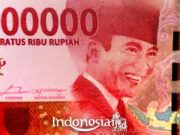Nommensen came from Noordstrand Island in Schleswig, then part of Denmark. His family lived in poverty and suffering, so that since childhood, Nommensen was used to living in these conditions. Therefore, since childhood, he has been earning a living to help his parents. When he was 7 years old, Nommensen chose to shepherd geese instead of attending school. At the age of 8, he started earning a living to help his parents by tending sheep. At the age of 9, he learned to be a roof roof. Then, at the age of 10, he worked for a rich farmer while learning to work the land. He also worked leading a horse that was pulling a plow to plow the land of the rich farmer. In 1846, when he was 12 years old, Nommensen had an accident. While he was playing chase with his friend, he was hit by a horse-drawn carriage which crushed his leg until it broke and this situation forced him to lie in bed for months. At that time, in prayer, Nommensen asked for healing and promised, if he was healed, he would preach the gospel to the unbelievers. After his leg recovered, Nommensen returned to farming to help his family after his father’s death.
At the age of 20, Nommensen went to Barmen (now Wuppertal) to apply to become an evangelist. For 4 years he studied at the zending Lutheran Rheinische Missionsgesellschaft (RMG) seminary. After graduating, he was then ordained a pastor in 1861.
*Following is a brief history of Ingwer Ludwig Nommensen:
- In 1854, Nommensen’s mother blessed her son, the only man among four children, to become a missionary .
- In 1857, Entered the pastor’s school at RMG Barmen after waiting so long.
- In 1858, January Her mother died in Nordstrand.
- Year 1861, October. Ordained as a priest and immediately dispatched by the Barmen mission to become a missionary to the land of Batak. But for some time he was still learning the Batak language and Batak culture from Dr. Van Der Tuuk in the Netherlands. Another source said he was also learning to learn more about Batak in Batavia.
- Year 1861, December. Departing from Amsterdam to Sumatra by ship Pertinar. The voyage took 142 days.
- Year 1862, 14 May. Landed in Padang. Furthermore, he lived in Barus. (The Pertinar ship then sank during a further voyage to the east around the Banda Sea near West Irian).
- In 1862, November. Together with some Batak people, they traveled to the interior of Sumatra via Barus and Tukka. From Barus, Nommensen went to Prausorat and later stayed with Van Asselt in Sarulla.
- Year 1863, November. First time visiting the Silindung Valley .
- Year 1864, May. After coordinating with the authorities (the Netherlands), he started his mission to Silindung.
- In 1864, July. Build his house in Saitnihuta.
- Year 1864, 30 July. Meet King Panggalamei to Pintubosi, Lobupining. King Panggalamei and his entourage of 80 people killed Pastor Hendry Lyman and Samuel Munson (missionaries sent by the Zending Baptist Church from America) in Sisangkak.
- Year 1864, 25 September. The conflict that caused Nommensen to be presented to Sombaon Siatas Barita in Onan Sitahuru. Thousands of people came. Nommensen will be killed as a sacrifice. Nommensen steadfastly faced challenges, he prayed, a tornado and heavy rain broke up the great party. Nommensen survived, since then the way was opened to the Word of God in a very cruel and savage land. Nommensen deserves the nickname “Apostel in the land of Batak” (Apostle in the land of Batak).
- Year 1865, 27 August. The first baptism in Silindung was for 4 husband and wife couples and their 5 children. Among the first baptized families was Si Jamalayu who was named Johannes and his wife who was brought from Sipirok as Nommensen’s helper named Katharina.
- In 1866, 16 March. Nommensen was blessed to be husband and wife with his fiancé Karoline in Sibolga. Karoline came from Germany along with Pdt. Johansen was sent by Barmen’s partner to help Nommensen in Silindung.
- In 1871, Nommensen suffered from dysentery and was brought by Johansen for treatment to Sidimpuan.
- In 1864, Karoline gave birth to her first child, named Benoni, but a few days later she died.
- In 1872, Pargodungan Saitnihuta called Huta Dame moved to Pearaja. After the new Church was almost completed, Nommensen’s first daughter, Anna, died. The Nommensen family has lost their first two children, what a tough test for missionaries to start their mission.
- In 1873, Sikola Mardalan-dalan (School with precarious places) was created by Nommensen so that the Batak people could quickly become teachers. Students came to Nommensen in Pearaja, Johansen in Pansurnapitu and Mohri in Sipoholon where the missionaries were on duty. Or, missionaries come to their students in certain places.
- In 1875, Missionary Nommensen, together with Johansen and Simoneit visited Toba.
- In 1876, Finished translating the New Testament into the Toba Batak language. It was also told that more than 7000 people had been baptized in Silindung.
- In 1877, Nommensen and Johansen founded the Zending Teacher School in Pansurnapitu. The place where the school was founded is a place that was formerly known as Pasombaonan (place haunted), which is now the location of the Pansurnapitu STM and the HKBP Pansurnapitu Church.
- In 1877, The XII King Sisingamangaraja threatened to burn missionary activities, this threat did not come true. Silindung entered the Dutch colonization.
- In 1880, Nommensen and his wife and children went to Europe._
- In 1881, Ahead of Christmas, Nommensen returned to Pearaja. He returned alone, his wife lives in Germany because she still needs treatment. Her children also live there so they can go to school well.
- In 1881, Kongsi Barmen appointed Nommensen to be HKBP’s first Ephorus (supreme leader), he was given the title ‘Ompu’.
- In 1887, Karoline, Nommensen’s wife, died in Germany, a month later Nommensen only found out about it ._
- In 1890, Nommensen started his mission to Toba, he moved to Sigumpar.
- Year 1891, May. Christian, Nommensen’s son, was killed in Pinang Sori by 5 Chinese coolies in the plantation area.
- In 1892, With Rev. Johansen who was also a widower, went to Germany for a vacation, visited his children, and looked for a new partner for each of the missionaries who had been widowed. Nommensen got his match, Mr. Harder’s son, Christine, Johansen got his match, Mr. Heinrich’s son named Dora. They returned to Batak land with each of their new partners.
- In 1900, The Beginning of Batak Zending.
- In 1903, The start of the Zending mission to Medan.
- In 1904, The Faculty of Theology, University of Bonn, Germany, awarded Nommensen the Honorary Doctor of theology title in the field of theology. During the inauguration, Queen Wilhelmina from the Netherlands was also invited as a guest.
- In 1905, Visiting Europe with Reitze, he visited the Zending mission in the Netherlands and visited Queen Wilhelmina .
- Year 1909, Christine Harder, Nomensen’s wife passed away, after giving birth to 3 children. He is buried in Sigumpar. Two of his daughters lived in Germany and were not married when Nommensen died at the age of 84.
- In 1911, Pesta Jubileum 50 years HKBP. The large party at Onan Sitahuru was attended by tens of thousands of people, at the place where 47 years earlier Nommensen had wanted to be killed and presented to Sombaon Siatas Barita. Queen Wilhelmina of the Netherlands awarded Nommensen an ‘Order Of Orange Nassau’, a service star only given to people who are considered extraordinary services in the humanitarian field.
- In 1912, Vacation to Europe, back to the land of Batak together Mr. Pilgram who has long served in Balige.
- In 1916, Nathanael son of Nommensen, was shot to death in the arena of World War I in France.
- Year 1918, 23 May. At 6am Thursday morning, Nommensen went to meet the Lord in heaven. She closed her eyes forever after praying ‘God into Your hands I surrender my spirit, amen’.
- On Friday afternoon, 24 May 1918. Nommensen was buried in Sigumpar. Tens of thousands of people came to mourn him to say goodbye. Some people say “This is the largest collection of people who have ever happened in the land of Batak.”
While in Batak land, Nommensen had established 510 schools with 32,700 students translating the New Testament in Batak in 1876. In his evangelistic work, he realized the need to include the indigenous Batak people. So for the needs of school teachers, he opened teacher education. Because of his prowess and services in evangelism, the leadership of the RMG appointed him Ephorus in 1881 and on his 70th birthday, the University of Bonn awarded Nommensen the title of Doctor Honoris Causa. Although not the first missionary to the land of Batak, Nommensen was the most important missionary in evangelizing there. Batak people give the title “Ompungta”; Our father, was not afraid even though he was poisoned, was arrested and was about to be presented to the gods, he was accused of being a Dutch spy so that he deserves the nickname “Apostle of the Batak people”. * Life history of DR. Ludwig Ingwer Nommensen *
Source : suarakristen































